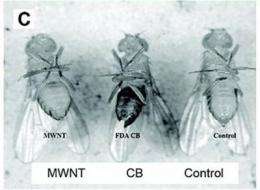New insights into health and environmental effects of carbon nanoparticles

Carbon nanoparticles are widely used in medicine, electronics, optics, materials science and architecture, but their health and environmental impact is not fully understood.
In a series of experiments, researchers at Brown University sought to determine how carbon nanoparticles would affect fruit flies — from the very young to adults.
The scientists found that larval Drosophila melanogaster showed no physical or reproductive effects from consuming carbon nanoparticles in their food. Yet adult Drosophila experienced a different fate. Tests showed adults immersed in tiny pits containing two varieties of carbon nanoparticles died within hours. Analyses of the dead flies revealed the carbon nanoparticles stuck to their bodies, covered their breathing holes, and coated their compound eyes. Scientists are unsure whether any of these afflictions led directly to the flies' death.
A separate experiment showed adult flies transported carbon nanoparticles and then deposited them elsewhere when they groomed themselves.
The findings, published online in Environmental Science & Technology, help to show the risks of carbon nanoparticles in the environment, said David Rand, professor of biology, who specializes in fruit fly evolution.
"The point is these same compounds that were not toxic to the (fruit fly) larvae were toxic to the adults in some cases, so there may be analogies to other toxic effects from fine particles," Rand, a co-corresponding author, said. "It may be like being in a coal mine. You get sick more from the effects of dust particles than from specific toxins in the dust."
The scientists immersed adult Drosophila in a control test tube and test tubes containing four different types of carbon nanoparticles corresponding with their commercial uses — carbon black (a powder much like printer toner), C60 (spherical molecules known as carbon buckyballs, named for Buckminster Fuller's geodesic designs), single-walled carbon nanotubes, and multiwalled carbon nanotubes. Flies in the test tubes with no carbon nanoparticles, C60 and the multiwalled nanotubes climbed up the tubes with few or no difficulties. But the batches of flies immersed in the carbon black and single-walled nanotubes could not escape their surroundings and died within six to 10 hours, the Brown scientists report.
The causes of death are unclear, but detailed analyses led by chemistry graduate student and lead author Xinyuan Liu showed the flies were affected physically. In some, the carbon nanoparticles covered them from wings to legs, which may have impeded their movement or weighted them down too much to climb. In others, the nanoparticles clogged their breathing holes, or spiracles, which may have suffocated them. In other adults, the nanoparticles covered the surface of their compound eyes, which may have blinded them.
The nanoparticles "glom onto the flies," Rand noted while watching a video of flies in the test tubes. "They just can't move. It's like a dinosaur falling into a tar pit." (Note to journalists: Video is available on request.)
Rand and Robert Hurt, director of Brown's Institute for Molecular and Nanoscale Innovation and the other corresponding author, said the findings are important, because they show that permutations of the same material — carbon — can have different effects in the environment.
"It's not the nanoparticle per se (that may be hazardous), but the form the nanoparticle is in," Rand said.
In another experiment led by Daniel Vinson, an undergraduate student in engineering, adult Drosophila coated in multiwalled carbon nanotubes carried the carbon on their bodies from one test tube into another and deposited some of the particles in the clean tube. That test showed how insects could be vectors for transporting nanomaterials, Rand said.
While two generations of fruit fly larvae showed no ill effects from eating carbon nanoparticles, the Brown scientists noticed that some of the particles ended up being stored in the flies' tissue. That means the nanoparticles could accumulate as they are passed up the food chain, Rand said.
The researchers have several related experiments in the works. They plan to test fruit flies' response to nanosilver and other nanomaterials with different chemistries, and they will investigate why the adult Drosophila died from varieties of the carbon nanoparticles.
Source: Brown University (news : web)
















